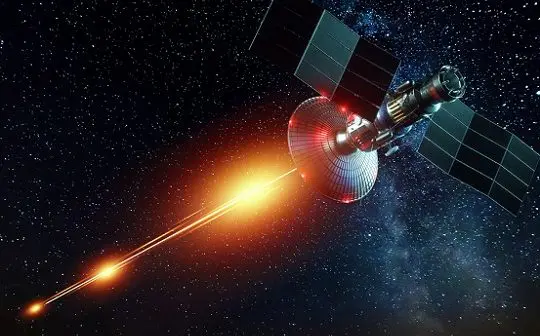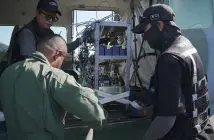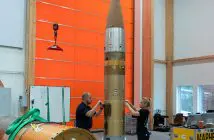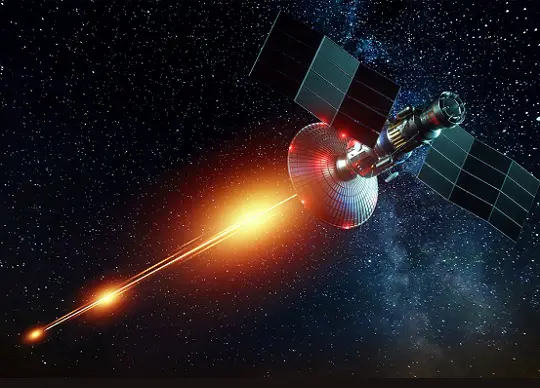
By Chris Flaherty
My Space Warfare Analysis Lab
INTRODUCTION
A conventional Space-based force is integrated into several Terrestrial-based layers of utilization: aerospace, land surface, sea surface, underseas and electronic for various uses of military force, to name a few. If we imagine a battle scenario where the relationship is severed, a Space-based force is alone, and is in competition against a Terrestrial-based force. This exploratory paper will look at how Terrestrial or Space-based forces compete against each other as opponents. This paper will introduce the Jominian-Space Model. It will look at a battle scenario between two radically asymmetric forces: Red, a Terrestrial-based force that makes use of Militarized Space; and Blue, a Space-based force that has Weaponized Space. The paper will end exploring implications of the oscillation between Militarized and Weaponized Space.
THE TERRESTRIAL AND SPACE PLANES
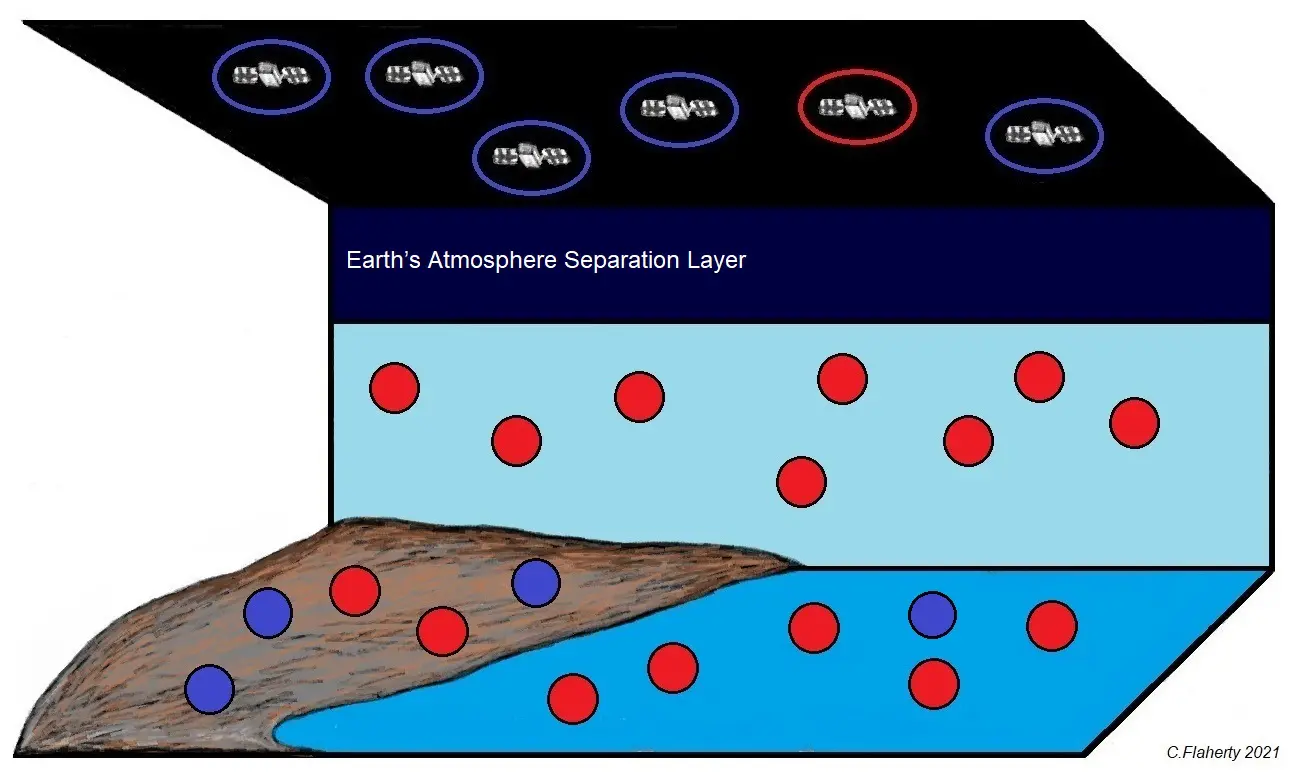
“FIGURE 1: The Space and Terrestrial Planes used by two opposing forces: Red, a Terrestrial-based force that makes use of Militarized Space; and Blue, a Space-based force that has Weaponized Space. Blue’s only forces on the Earth’s surface, are command and control bases, satellite antenna, rocket launching and landing facilities, that can include a sea-going mobile platform or ship. The bulk of Blue’s force is a Space fleet of weapon bearing spacecraft-satellites. Whereas, the Red force have military-use satellites passively supporting their conventional land surface, sea surface, underseas, and air forces. Red primarily dominates the Terrestrial Plane, and Blue the Space Plane. A notional layer of the Earth’s atmosphere constrains (because of technological limitations) manoeuvre between the Planes by Red or Blue.”
FIGURE 1: This exploratory paper looks at how Terrestrial-based and Space-based forces compete against each other as opponents. To begin with, imagine two facing surfaces. One surface is the Space Plane containing a Space-based fleet of weapon carrying spacecraft-satellites. The other surface facing it is the Terrestrial Plane. Separating the Space and Terrestrial Planes is the three-dimensional volume of aerospace beginning at the Earth’s surface, and ending at the outer-limits of Earth’s atmosphere, and the Edge of Space. This is not continuous, as the Space and Terrestrial Planes are separated by the Earth’s Atmosphere Separation Layer: a notional layer of the Earth’s atmosphere that constrains (because of current technological limitations) manoeuvre by a Terrestrial-based force from entering Space, and a Space-based force from easy passing from one Plane to the other. The only exception is weapons use. This interfacing level represents a radical transition from the zone of Earth’s atmosphere that sustains conventional flight – the Troposphere and the Stratosphere (that can support Stratospheric ballooning), and the Edge of Space, where a craft can escape Earth’s gravity, make Sub-Orbital Space Flight, enter into Low Earth Orbit, circumnavigate the Earth, or travel to Cislunar and Mars Space.
TERRESTRIAL AND SPACE JOMINIAN CUBES
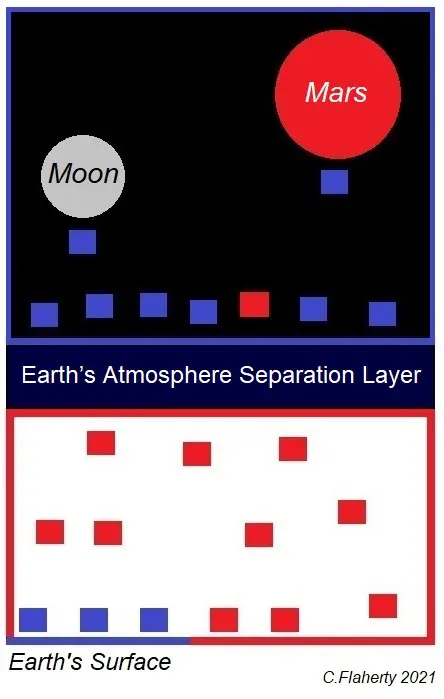
“FIGURE 2: The Jominian-Space Model. Two combatant forces are Red a Terrestrial-based force, that has a land surface, sea surface, undersea, and air forces supported by military-use satellites. Blue a Space-based force, has surface-based launch-landing, command and control, satellite antenna communication links to a Weaponized Space fleet of spacecraft-satellites. The Space-based force also has Space depth into Cislunar and Mars Space which it can occupy with additional command and control bases, satellite antenna, and so on.”
FIGURE 2: Illustrates a model based on the Jominian Fundamental Principles of War (Jomini, 1862). The classical Jominian operational area was conceived as a four-sided field. Each opponent controlled one side. One or the other used battle and manoeuvre in order to gain control of more sides, ultimately diminishing the ability of one of the opponents to manoeuvre, be out-flanked and defeated separated from their logistical base. Transitioning from the 19th Century to 20th Century war, we turn the Jominian four-sided field into a three-dimensional cube – the current operational theatre, incorporating the Earth’s surface, and the aerospace above it. If we further transition from the 20th Century to the 21st Century, into the Age of Space War, and the beginning of Space-to-Space War, we must stack a second cube above the first. This represents the expanse of Space beyond Earth’s atmosphere – the edge of Space, that includes Sub-Orbital Space Flight, Low Earth Orbit, Cislunar, and Mars Space. This we can call the Jominian-Space Model.
Using the Jominian-Space Model we can further visualized two three-dimensional cubes stacked one on top of the other: the Terrestrial Jominian Cube, and the Space Jominian Cube. The radical problem faced by a Space-based force, is that it is effectively separated into one or both of the stacked cubes. The Space-based force only partly occupies the base-side (Earth’s surface) of the Terrestrial Jominian Cube.
Militarized and Weaponized Space
The Space-based force has components that are Terrestrial-based: launch-landing facilities (on land or mobile at sea), command and control (where its Space fleet pilots are), and satellite antenna communications links with the Space fleet. The Space-based force has full-depth
occupation of the adjacent Space Jominian Cube. Exterior depth, is created by having access to Cislunar and Mars Space. Strategic depth is also having near total occupation of all the useful orbits, and the strategic Lagrange Points in the solar system, and by having bases on the Earth’s Moon, and Mars. Located in the Space Jominian Cube are all the Space-based force’s fleet of weapon bearing spacecraft-satellites permanently orbiting the Earth. Except for its fleet reserve awaiting launching from the Earth’s surface. At this stage in history, the craft are not crewed with Humans or Robotic assistants, these are piloted from the Earth’s surface (or from bases on the Earth’s Moon, or Mars).
The opponent Terrestrial-based force occupies part of the same side (as that of the Space-based force), and the rest of the sides of the Terrestrial Jominian Cube, and all the aerospace. The Terrestrial-based force has nearly full-depth occupation within the Terrestrial Jominian Cube. The key difference between the Terrestrial-based and Space-based forces is the former has Militarized Space; it makes passive use of military-use satellites to support military planning and operations on Earth (Harrison, 2021). Military-use satellites aid communications, navigation (global positioning), surveillance, reconnaissance, and meteorological information spheres of warfare, and these vastly increase the precision and manoeuvrability of a Terrestrial-based force. The Space-based force, on the other hand, has Weaponized Space, its Space fleet of spacecraft-satellites represent a variety of kill-vehicles (with kinetic, or non-kinetic weapons) capable of destroying, or denying use of a military-use satellite, and attacking targets on the Earth’s surface or in aerospace.
RED TERRESTRIAL VERSUS BLUE SPACE FORCES
The Jominian-Space Model as we have conceived it, has two asymmetric forces: Red, a Terrestrial-based force that makes use of Militarized Space; and Blue, a Space-based force that has Weaponized Space in conflict with each other. The Red and Blue forces are constrained from easy manoeuvre from one Plane (Cube) to the other by technology limitations, except for weapons, that are able to cross the Earth’s Atmosphere Separation Layer, from one Plane to the next. Each force is largely composed of craft that only operate in Space, on the Earth’s surface, or in aerospace. The Red force, has much greater military power on the Earth’s surface, and in aerospace. Its ability to reach higher into Earth’s atmosphere is limited to a set of height ceilings. It can only project into the Earth’s Atmosphere as far as conventional flight into the Troposphere and into the Stratosphere, that can support Stratospheric ballooning.
A weapon attack: kinetic, or non-kinetic, can begin on the Space Plane, and strike a target on the Terrestrial Plane, or vice versa. For the Red Terrestrial-based force, its war-options are Earth-to-Earth, or Earth-to-Space weapons. War-options for the Blue Space-based force are equally asymmetrical, namely: Space-to-Space, or Space-to-Earth weapons. Red’s ability to launch an attack through the higher levels of Earth’s atmosphere across the Edge of Space, is only achievable with anti-satellites missiles (ASAT), and ground-based laser batteries. The ASAT can have conventional or nuclear warhead, or other type of projectile directly striking or detonating near a targeted spacecraft-satellite (Harrison, 2021). An example, of anti-satellites laser batteries, would be the current Russian Peresvet Laser (2018 till present) that conceals the movements of road-mobile Intercontinental Ballistic Missiles by temporarily affecting imaging capabilities, dazzling or permanently blinding optical systems of enemy reconnaissance satellites while passing over (Hendrickx, 2020).
One of the significant problems faced by a Blue Space-based force, would be dealing with kinetic Earth-to-Space weapons, as these can produce debris that can affect the safe operation of other satellites in affected orbits (Harrison, 2021). In 2007, China demonstrated an anti-satellite missile (ASAT) destroying one of its own defunct satellites generating a huge new
swarm of orbital debris (David, 2007). A prolonged campaign of destroying a fleet of spacecraft-satellites could create orbitally, a massive debris cloud that could systematically destroy other spacecraft-satellites, space stations, civil, and other military-use satellites in its path. The consequence would be to make:
“the fragile and shared domain of Outer Space … become … an arena for conflict … [doing so]… could lead to devastation, disruption and impact on civilian lives, particularly in the largest and most powerful countries like the U.S., whose economies and societies are heavily dependent on Space infrastructure. Their access to Space has given them the greatest competitive advantage, but they are therefore the most vulnerable if that access is compromised.” (Freeland, 2021)
A Blue Space-based force, is weaker on the ground, as its ground-based control centres, land based launch-landing, and mobile launch-landing platforms at sea (sea carriers), and its satellite antenna communications can be found, and destroyed by the Red Terrestrial-based force. It has a large Space fleet of weapon bearing spacecraft-satellites that can destroy the Red force’s military-use satellites, severely effecting that forces ability to coordinate, manoeuvre and target, as well as attack surface, and aerospace targets.
A Blue Space-based fleet of spacecraft-satellites also has the ability to circumnavigate the Earth, giving it global coverage, so it is not always visible to the Red force, as it is protected by the Earth’s curvature, and orbits at regular intervals moving in relation to the Earth’s rotation at a much faster speed. A Space-based force can also rely on a strategy on the Earth’s surface, “[using]… ground station architectures that are more difficult for an adversary to attack.” (Harrison, 2021). Such as camouflaging, using deception, and deep-bunkers for its ground control and satellite antenna. It can have multiple redundancy, as a strategy to mitigate facility losses from a Red force attack. It can even preserve its rocket launch-landing facilities, by putting these on sea-going vessels and mobile platform vessels (based on oil rigs).
In Space, a Space-based force can have, “architectural defences … that rely primarily on satellite constellation” (Harrison, 2021). For instance, there can be proliferated constellations, that deploy larger numbers of the same types of spacecraft-satellites in similar orbits performing the same missions (Harrison, 2021). Proliferated constellations that place more spacecraft-satellites on an orbital flight path while increasing the size and overall capacity of a fleet can lead to a type of defacto occupation of an area of Space. For instance, if an entity such as a state, or commercial enterprise was to place a huge number of spacecraft-satellites along a particular orbital slot, “[this]… essentially cedes that orbit to that … [entity]” (Samson, 2021).
Currently, a considerable problem of Earth’s spacecraft-satellite layer it has crowded orbits, increasingly cluttered with dead and defunct craft, and debris. Orbital crowding can fundamentally constrain manoeuvre opportunities within an orbit, or moving to another one, in the case of rendezvous and proximity operations between craft in Space (Samson, 2021). It is also possible to conceive of a future strategic-tactical advantage in having old spacecraft-satellites used as decoys, and cover for other craft. Orbital crowding can be used to increase deception and manoeuvre opportunities by two adversaries in a Space-to-Space battle, and the avoidance of Earth-to-Space weapons used by the Red Terrestrial-based force.
A Red Terrestrial-based force, in the face of the destruction of their military-use satellites, will likely only suffer momentary set-backs. While loss of its military-use satellites will deny effective support of its capacity to manoeuvre, find, and target its opponent in Space and on the ground, Red can nevertheless return to the ‘old ways’ of warfare. Resorting to substitutions, such as air surveillance using conventional high-altitude aircraft like the Lockheed U-2, that
has a flight ceiling of 70,000 feet: 21,300 meters. This family of reconnaissance aircraft include the Lockheed Martin SR-72, the role of which is to plug the coverage gap from surveillance satellites. Precision-guidance while made possible by Space Militarization may still possibly be substituted by modules carried by Stratospheric balloons, aiding communications, navigation, surveillance, reconnaissance, and meteorological information. Alongside the substitution options, the Red force still has the further option of using the ‘old-war’ techniques of mass-bombings, and massive-strike options such as nuclear weapons.
THE THIRD BOXER IN THE DARK
A high dependency of the Red Terrestrial-based force on its military-use satellites to manoeuvre, communicate and fight needs to be viewed in the context, that if lost a warship, airplane, submarine or land combat force could still find, and attack an opponent. Whereas, a major vulnerability for the Blue Space-based force’s fleet, it could be rendered helpless if its entire command and control is shut-down on the surface of the Earth. Access to a Lunar Base, on the Earth’s Moon, or indeed the now-realisable possibility of a Human settlement – base on Mars, could see a return to the notion of the ‘third boxer in the dark’ (Flaherty, 2021).
The notion of a Lunar Strategy: the use of the Earth’s Moon, as a place to attack the Earth’s surface or a potential source of military threat to the Earth’s surface can be viewed, as was originally conceived in the 1950s, as a Bi-Planetary Strategy (Boushey, 1958; Sambaluk, 2011). Largely a punch, counter-punch set of exchanges, not unlike the two boxers fighting in the dark (Hart, 1920). The Bi-Planetary Strategy postulates a third boxer in the dark (on the Moon), fighting alongside one of the two principal boxers in a match (the U.S. and Soviets on Earth). This third boxer coming-in from the depth of Space could be the strategic game-changer in a war between Red and Blue.
Timing Constraint in Space-to-Space War
Another asymmetric issue in relation to the two opposing forces: Red, a Terrestrial-based force and its Blue, a Space-based force opponent would be heavily constrained by the limits physics imposes on movement in Space, and the limitations imposed by time. In relation to organizing an attack, if the Blue force were the initiator, it would likely require deliberate planning, with its fleet of spacecraft – satellites, “manoeuvring for days, if not weeks or months, beforehand to get into position to have meaningful operational effects.” (Reesman, 2020) Use of saturated orbital paths circumnavigating the Earth, or the use of deception and camouflaging behind orbiting debris could be used to create a better tactical-strategic position in Space. Once, orbital planes are matched, and the timing set-up through precise orbital phasing, this could create many opportunities to manoeuvre close enough to engage a target quickly (Reesman, 2020).
WHO WINS?
This exploratory paper has sought to build a Space War version of the Jominian fundamentals looking at an asymmetric battle scenario between the Red Terrestrial-based force that makes use of Militarized Space and Blue Space-based force that has Weaponized Space. The possible destruction on the Earth’s surface of Blue force’s remaining ground control, or satellite antenna could foreseeably lead to a more radical scenario where there is a transfer of command and control functions to a space station, Lunar, or Mars bases. Off-world bases taking-over the command and control of the Space fleet, could continue the war against the opponent on the Earth’s surface making this a type of interplanetary conflict. This could lead to attacks on ground and sea launching-landing facilities, and anti-satellite weapons: ASAT, or laser batteries. This may actually widen the war to a global one, as these would need to be targeted worldwide to stop the Red force from using facilities it has access globally, such as its allies,
attempting to attack the Blue force’s fleet in Space. The Blue force, could also have access to satellite construction in Space, the Moon, or on Mars to replenish its losses and keep fighting.
The battle scenario envisaged in this exploratory paper has pitted two combatants in a radical asymmetric relationship to each other. The Blue Space-based force is radically inverted in relation to a more conventional Red Terrestrial-based force in that its ability to deliver kinetic, and non-kinetic attacks is done by a Space fleet of spacecraft-satellites. The craft are not crewed but are piloted by Humans from a Earth, Moon, or Mars command and control bases. The ability to attack is exclusively conducted from Space, as fresh spacecraft-satellites orbit overhead to attack, or de-orbit to do so.
The ability to saturate Orbital Space with a massed Space fleet of spacecraft-satellites would test the ‘normal’ parameters of Space-Based War. In current thinking the object,
“[is]… not necessarily to physically conquer sectors of Space but rather to reduce or eliminate adversary satellite capabilities while ensuring one retains the ability to freely operate their own Space capabilities.” (Reesman, 2020)
Mass filling-out of advantageous orbits with multiple craft will likely achieve a defacto occupation of that orbit, hence that portion of Space. This will likely not come without risks, as anyone, or several of the spacecraft-satellites could come under attack from the surface of the Earth, or from aerospace. If kinetic weapons are used, these will likely create debris masses that catch-up with, collect, consume and destroy successive spacecraft-satellites as the mass moves along an orbital flight-path where an attack had been initially aimed.
FUTURE TERRESTRIAL-BASED, AND SPACE-BASED FORCES DEVELOPMENT
The future development of Red Terrestrial-based, and Blue Space-based forces, would likely follow one of several dynamic directions, such as both forces mirroring, and there would be a progression from Militarization of Space to its Weaponization. This would be effected in one of four transitional, and converging technologies: (1) Terrestrial point-to-point rocket launch and landing travel; (2) Spaceplanes; (3) Space stations to space warships; and, (4) Armoured orbital space stations.
(1) Terrestrial Point-to-Point Rocket Launch-Landing Travel
A Terrestrial ‘troop carrier’ point-to-point rocket launch and landing craft can be envisaged. Essentially a single-stage to orbit craft, this can be anticipated coming into use with the ability to build a large cargo and Human carrying spacecraft, able to make Sub-Orbital Space Flight, or fully circumnavigate the Earth in Low Earth Orbit. It would need to have the ability to make a controlled landing anywhere on the Earth’s land surface, or on a sea carrier-landing ship. The phase would represent the Militarized use of Space. However, these ‘troop carriers’ could become armed – Weaponized, initiating a new era in Space War.
(2) Spaceplanes
It can be anticipated both the Red Terrestrial-based, and Blue Space-based forces would have access to small uncrewed (robotic) spaceplanes, like the: Orbital Robotic Spaceplane Boeing X-37 (U.S. Air Force, 2020), or the Chinese Shenlong Reusable Robotic Spaceplane (Global Security); and Human (and possibly Robotic) crewed Dream Chaser (Sierra Nevada Corporation). Launched into Low Earth Orbit, carrying crews and cargo, or robotically operated versions, the craft would port with orbital space stations (to then return to the Earth’s surface landing like conventional aircraft on runways). In the early 1960s, both the U.S. and Soviets looked at Earth circumnavigation with space bombers in Low Earth Orbit as a new type
of global-reach strategic bombing. These early concepts could see reapplication, with Weaponization of the coming generation of small spaceplanes.
(3) Space Stations to Space Warships
The next radical step in Red Terrestrial-based, and Blue Space-based forces development would likely be towards Human and robotic piloted spacecraft, evolving beyond the current satellites into larger more complex craft and following the historical trend beginning in 1971, with the Soviet armed Almaz Space Station. The Almaz had an externally mounted machine gun cannon to defend against American astronaut attacks (Reesman, 2020). A transitory stage in the evolution of the spacecraft-warship, would be craft closer in kind to the current class of orbital space stations. The orbital space station: spacecraft-warships would still have a degree of manoeuvrability, left uncrewed and piloted from the ground, or receive crews to take direct control. Transition craft like these, would be armoured.
(4) Armoured Orbital Space Stations
In general, the orbital space stations, still technically spacecraft have less orbital manoeuvre than a satellite, and they are heavily protected with armoured shielding to withstand debris and small meteoroid strikes. It is open to question as to how an orbital space station would fare in a conflict if attacked. These are large targets not easily camouflaged or hidden in Low Earth Orbit. The Soviets hid their Almaz Space Station making these identical to the Salyut craft. The International Space Station (ISS) is currently one of the largest Human structures in Low Earth Orbit, at about 356 feet by 240 feet, larger than a football field, and weighing-in at 450 tons (Popular Mechanics). The next generation Low Earth Orbit space stations, such as the Axiom (Axiom Space), will be smaller. The Axiom is more likely to be the same scale as China’s Large Modular Space Station, that is generally understood (when completed in 2032), will be around one-fifth the mass of the International Space Station (ISS), about the size of the Soviet, later Russian Mir Space Station, having a mass of around 66 metric-tons (Jones, 2020).
Armoured orbital space stations, while better defended, would nevertheless be first-strike targets in the opening stages of a Space War. It should be noted, that far-back in the Cold War Era, a principle of deterrence against malevolent actions in Space was the threat of a nuclear response (Harrison, 2021). Potentially a prelude to war, might be attacks on military-use satellites, orbital space stations, or spacecraft-satellites. Such an action was seen as tantamount to the prelude to a nuclear attack by one state on another, which would see an automatic counter-nuclear strike beginning the escalation cycle to MAD (Mutually Assured Destruction).
DEWEAPONIZATION OF SPACE
Progression from Militarization to Weaponization of Space has been reversed in the past. The result of the 1967 Outer Space Treaty, that broadly banned stationing of weapons of mass destruction in Outer Space, and prohibited military activities on celestial bodies (United Nations). In recent times, the United Nations Committee on the Peaceful Uses of Outer Space has,
“noted with alarm that preventing conflicts in Outer Space and preserving Outer Space for peaceful purposes is more necessary than ever.” (United Nations, 2019; Freeland, 2021)
One of the basic predicaments of the 1967 Outer Space Treaty it did not preclude the Militarization of Space. This has even seen creation of a legal regime on the International Space Law applicable to military uses of Outer Space in peacetime (McGill, 2016). Since 2020, there has been an exponential increase in the pace of Space activity. Increasing commercial use of Space, has raised the prospect of large numbers of Humans in Space. A real possibility is the need to protect Critical Space Infrastructure. A potentially, massive surge of Human activity in Low Earth Orbit, Cislunar, and Mars Space, and corresponding transformation in Space Military Technology raises the practical need for a type of patrolling and policing potentially using defensive weapons to protect legitimate Space activity, operating in accordance with International Space Laws. Revealing a pattern of constant oscillation between Militarization and Weaponization of Space, which will dominate Space Relations.
- References
- • Axiom Space. Explore Axiom Station. Fact Sheet.
• Boushey, H.A. 1958 Lunar Base Vital. Army-Navy-Air Force Register. Number 79 (8 February).
• David, L. 2007 China’s Anti-Satellite Test: Worrisome Debris Cloud Circles Earth. Space.com Website (2 February).
• Flaherty, C. 2021 The War Rocket. My Security Marketplace Website (3 March).
• Freeland, S. Chen, D.K-W. Jakhu, R,S. 2021 War in Space Would be a Catastrophe. A Return to Rules-Based Cooperation is the Only Way to Keep Space Peaceful. Space.com Website (3 January).
• Global Security. Project 863-706 Shenlong (‘Divine Dragon’) Reusable Test Spacecraft. Fact Sheet.
• Harrison, T. Johnson, K. Young, M. 2021 Defense Against the Dark Arts in Space: Protecting Space Systems from Counterspace Weapons. A Report of the CSIS Aerospace Security Project. Rowman & Littlefield (February).
• Hart, B.H.L. 1920 The Essential Principles of War. United Services Magazine (April).
• Hendrickx, B. 2020 Peresvet: A Russian Mobile Laser System to Dazzle Enemy Satellites. The Space Review Website (15 June).
• Jomini, A. H. (de, Baron) (Mendell, G.H. Craighill, W.P. Translators) 1862 The Art of War. U.S. Military Academy, West Point, N.Y.
• Jones, A. 2020 China Outlines Intense Space Station Launch Schedule, New Astronaut Selection. Space News (28 May).
• McGill. 2016 Manual on International Law Applicable to Military Uses of Outer Space (MILAMOS). McGill Centre for Research in Air and Space Law.
• Newcomb, T. 2017 7 of the Biggest Things We’ve Sent to Space. So far, Anyway. Popular Mechanics (13 February).
• Reesman, R. Wilson, J.R. 2020 The Physics of Space War: How Orbital Dynamics Constrain Space-to-Space Engagements. The Aerospace Corporation (October).
• Sambaluk, N.M. 2011 What’s a Heaven For? National Public Culture’s Role in Shaping U.S. Space Policy, Aerospace Doctrine, and the Future of the Dyna-Soar, 1957-61. Dissertation. The University of Kansas.
• Samson, V. 2021 Threats to Space Aren’t Just Weapons. TRENDS Research & Advisory (24 February).
• Sierra Nevada Corporation. Dream Chaser. Fact Sheet.
• United Nations. Office for Outer Space Affairs (UNOOSA). Resolution Adopted by The General Assembly 2222 (XXI). Treaty on Principles Governing the Activities of States in the Exploration and Use of Outer Space, Including the Moon and Other Celestial Bodies.
• United Nations. 2019 Report of the Committee on the Peaceful Uses of Outer Space. Sixty-Second Session (12–21 June). General Assembly Official Records Seventy-fourth Session Supplement No. 20.
• U.S. Air Force [United States Air Force]. 2020 X-37B Orbital Test Vehicle. Fact Sheet.
AUTHOR
Chris Flaherty authored the Terrorism Research Center’s report – Dangerous Minds (2012). He was the co-primary author, along with Robert J. Bunker of the book – Body Cavity Bombers: The New Martyrs (iUniverse, 2013). Two essays of his, from 2003 and 2010 were reprinted in the Terrorism Research Center’s book – Fifth Dimensional Operations (iUniverse, 2014). He recently contributed a book chapter – The Role of CCTV in Terrorist TTPs, edited by Dave Dilegge, Robert J. Bunker, John P. Sullivan, and Alma Keshavarz, the book – Blood and Concrete: 21st Century Conflict in Urban Centers and Megacities, a Small Wars Journal anthology, published on behalf of the Small Wars Foundation with Xlibris (2019). Chris Flaherty is currently a Space & Defense Tech and Security News Regular Contributor.
CONTACT DETAILS: Dr Chris Flaherty https://au.linkedin.com/in/drchrisflaherty

